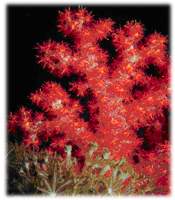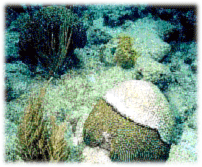Marine Biotechnology
 Biotechnology is defined as the industrial use of living organisms or biological techniques developed through basic research; marine biotechnology is an emerging discipline based on the use of marine natural resources. The oceans encompass about 71% of the surface of our planet, but over 99% of the biosphere (since organisms are found throughout the water column), and they represent the greatest extremes of temperature, light, and pressure encountered by life. Adaptation to these harsh environments has led to a rich marine bio- and genetic-diversity with potential biotechnological applications related to drug discovery, environmental remediation, increasing sea food supply and safety, and developing new resources and industrial processes.
Biotechnology is defined as the industrial use of living organisms or biological techniques developed through basic research; marine biotechnology is an emerging discipline based on the use of marine natural resources. The oceans encompass about 71% of the surface of our planet, but over 99% of the biosphere (since organisms are found throughout the water column), and they represent the greatest extremes of temperature, light, and pressure encountered by life. Adaptation to these harsh environments has led to a rich marine bio- and genetic-diversity with potential biotechnological applications related to drug discovery, environmental remediation, increasing sea food supply and safety, and developing new resources and industrial processes.
Why is Marine Biotechnology Important?
More than 80 percent of the Earth's living organisms are found only in aquatic ecosystems, and we know little about the biochemical characteristics. Our challenge as a nation is to discover the life-enhancing and lifesaving properties these unique organisms possess.
About 40 percent of coastal waters are currently unfit for swimming because of bacteria and pollutants. Our challenge is to develop the biological technologies needed to identify sources of ecological stress to develop strategies to protect and restore coastal resources.
Understanding the dynamics of fish populations and the impact of disease is essential to manage resources. Our challenge is to develop molecular technologies that will enable scientists and managers to differentiate populations and address emerging diseases to protect fishery and ecological resources.
Seafood-borne illness adversely affects public health and coastal economies. Our challenge is to use molecular technology to develop rapid diagnostic assays that ensure the safety of the seafood we eat and the vitality of the seafood industry.
Drug Discovery and Marine-derived Compounds
Drug discovery represents one of the most promising and highly visible outcomes of marine biotechnology research. Biochemicals produced by marine invertebrates, algae and bacteria, are very different than those from related terrestrial organisms and thus offer great potential as new classes of medicines. To date, examples of marine-derived drugs include an antibiotic from a fungi, two closely related compounds from a sponge that treat cancer and the herpes virus, and a neurotoxin from a snail that has painkiller properties making it 10,000 times more potent than morphine ithout the side effects. However, there are several more marine-derived compounds currently in clinical trials and it is likely that many more will advance to the clinic as more scientists look to the sea for these biotechnological uses. In addition to new medicines, other uses for marine-derived compounds include: cosmetics (algae, crustacean and sea fan compounds), nutritional supplements (algae and fish compounds), artificial bone (corals), and industrial applications (fluorescent compounds from jellyfish, novel glues from mussels, and heat resistant enzymes from deep-sea bacteria).
Marine Biotechnology and Environmental Conservation
 Biotechnology also holds the promise of increasing food supplies from the ocean; this is critical as overfishing and increased demand have taxed the limits of marine sustainable stocks. Aquaculture techniques have been enhanced by the discovery of natural inducers for spawning and larval settlement, as well as remediation of disease within culture facilities. Molecular genetic studies have also been applied to fisheries to identify natural populations and mixed stock interactions, and to estimate stocking efficiencies with pedigree. More recently, biotechnology has been used to assess seafood safety through the development of novel test kits that react to the presence of human pathogens in the food. These "biosensor" techniques are currently being employed as early warning systems for environmental health. For example, harmful algal blooms and/or anthropogenic toxins have the potential to cause great harm to marine habitats. Unique biosensors are being developed to inform scientists of increasing levels of specific biomarkers.
Biotechnology also holds the promise of increasing food supplies from the ocean; this is critical as overfishing and increased demand have taxed the limits of marine sustainable stocks. Aquaculture techniques have been enhanced by the discovery of natural inducers for spawning and larval settlement, as well as remediation of disease within culture facilities. Molecular genetic studies have also been applied to fisheries to identify natural populations and mixed stock interactions, and to estimate stocking efficiencies with pedigree. More recently, biotechnology has been used to assess seafood safety through the development of novel test kits that react to the presence of human pathogens in the food. These "biosensor" techniques are currently being employed as early warning systems for environmental health. For example, harmful algal blooms and/or anthropogenic toxins have the potential to cause great harm to marine habitats. Unique biosensors are being developed to inform scientists of increasing levels of specific biomarkers.
 Deep Sea Crabs
Deep Sea Crabs